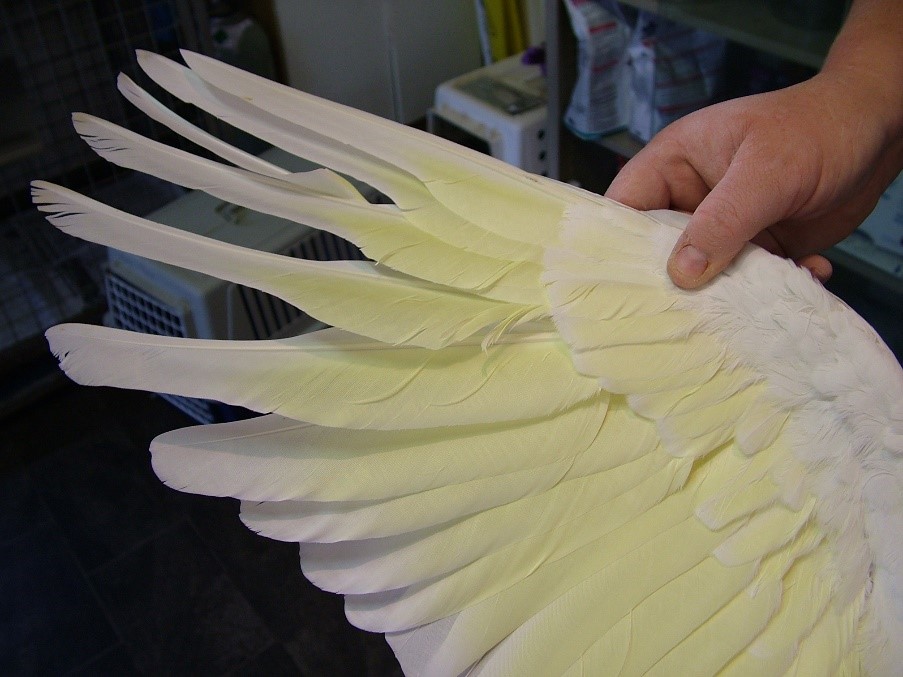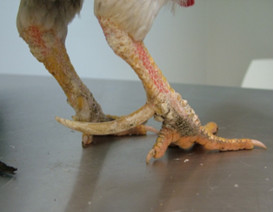Wing trimming/clipping
Wing trimming is sometimes required when chickens are flying over fences into dangerous or restricted areas (raised garden beds, pools, etc.). The concept of wing clipping is not to prevent flight completely, but rather to reduce the chicken’s ability to gain height and speed. Most chickens are too heavy to fly to great heights, but light-bodied birds can easily clear a two-metre fence. Even within the heavier breeds, there are individuals with enough determination and wing strength to get high off the ground. Always remember that clipping is not a guarantee the bird cannot fly – even with a properly performed clip, some birds will still manage to get over fences.
Always trim both wings. While trimming one wing only makes the bird unbalanced and flying difficult, it also makes landing awkward and potentially dangerous. Only clip the long stiff primary feathers, not the secondaries. The primaries are the long feathers coming off the end of the wing (from the wrist to the wing tip). Your bird needs their secondary and tertiary feathers to slow down and land safely.
Cut the feathers approximately 5-10mm from the distal edge (the edge furthest from the centre of the body) of the coverts (these are the contour feathers that overlap and cover the bases of the flight feathers) – this avoids cutting through a ‘blood quill’ – a newly erupted feather with blood vessels and nerves in the shaft. The trim will need to be repeated after each moult, as the stumps of the cut feathers will drop out and new primaries will come in.


Do not trim a bird’s wings until they have learned to fly. It is only by flying that your bird can learn how to land – which is the most difficult part of flight. More birds are injured by clumsy landings than anything else associated with flight.
Nail trimming
Like other birds, the nails and spurs of chickens will overgrow if they are not worn down naturally by scratching in the soil. Overgrowth occurs when:
- The chickens do not have the opportunity to scratch in firm soil e.g., if they are kept on soft litter or wire floors.
- If their conformation (structure), either congenital or acquired, results in uneven weight bearing on the feet and subsequent nail overgrowth. Some breeds, such as Silky bantams, have such bizarre feet conformation that regular nail trimming is required.
- Cnemidocoptes (Scaly leg mite) can cause hyperkeratinisation (thickening due to build up of keratin) of the podotheca (the scaly covering of the foot of a bird) and nails.
- The spurs, mainly on roosters but sometimes on hens, do not come into wear at all and can become long and dangerous to other birds and even people.
Left untrimmed, overgrown nails can alter the feet and weightbearing, resulting in lameness and/or pododermatitis (infection in the sole of the foot).
Trimming your chicken’s nails is similar to trimming the nails on a dog. An appropriately sized pair of nail trimmers is usually sufficient, although large nails and spurs may require trimming with a rotary hobby grinder. If any bleeding results, it can usually be stopped with the application of dry Condy’s crystals (potassium permanganate).
A permanent solution to rooster spurs is to amputate the spur level with the skin. This must only be done by a veterinarian under general anaesthesia. Appropriate pain relief and antibiotic coverage should be given for 3-5 days. Occasionally the spur will regrow but usually not as long as the original.

References
Echols S (2021) Anseriforme husbandry and management. In: Greenacre C, Morishita T (eds) Backyard Poultry Medicine and Surgery: A Guide for Veterinary Practitioners. John Wiley & Sons, Inc, pp 368–380
Raftery A, Silvetti S (2019) Orthopaedic surgery. In: BSAVA Manual of Backyard Poultry Medicine and Surgery. British Small Animal Veterinary Association , pp 281–290

